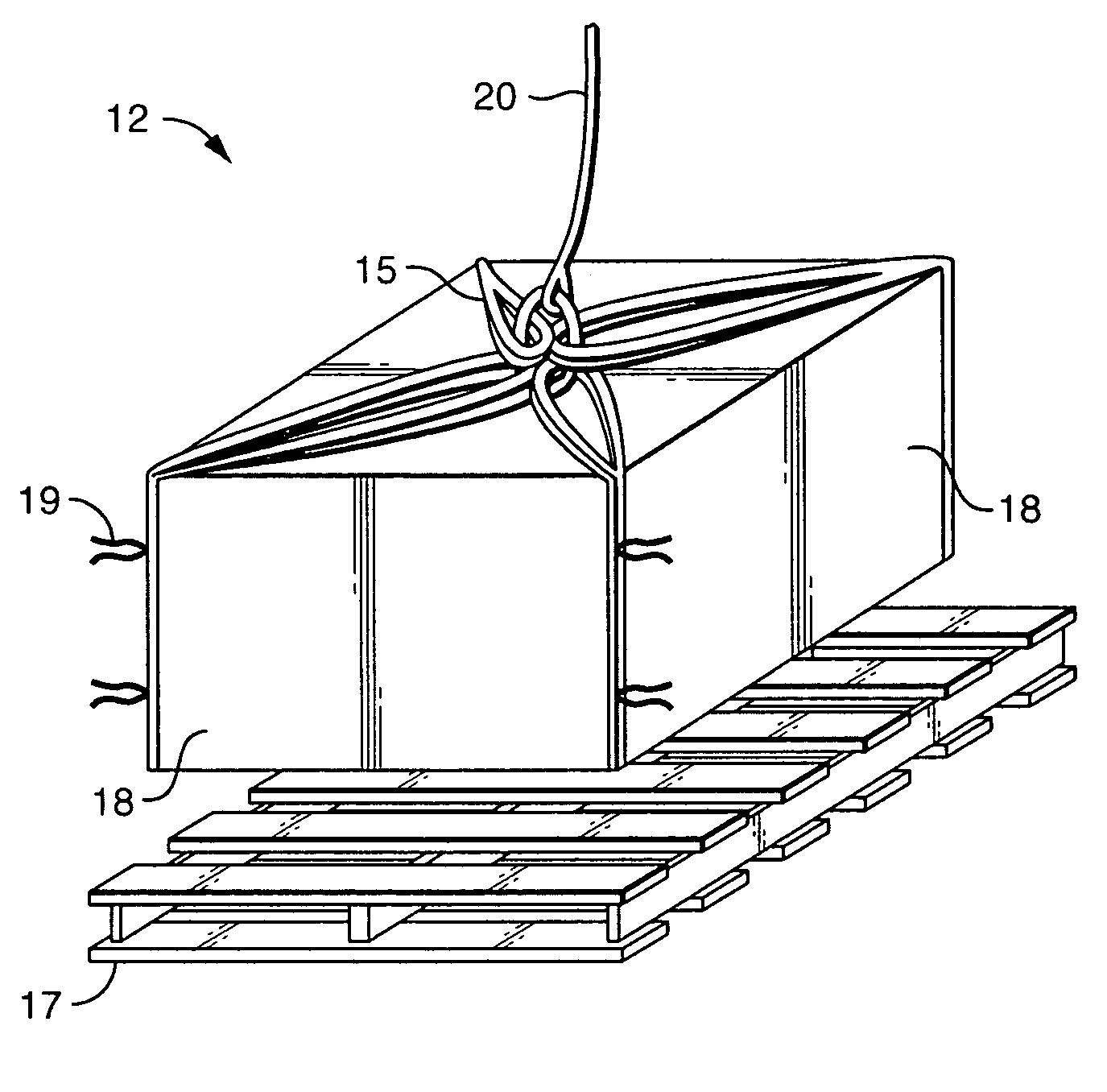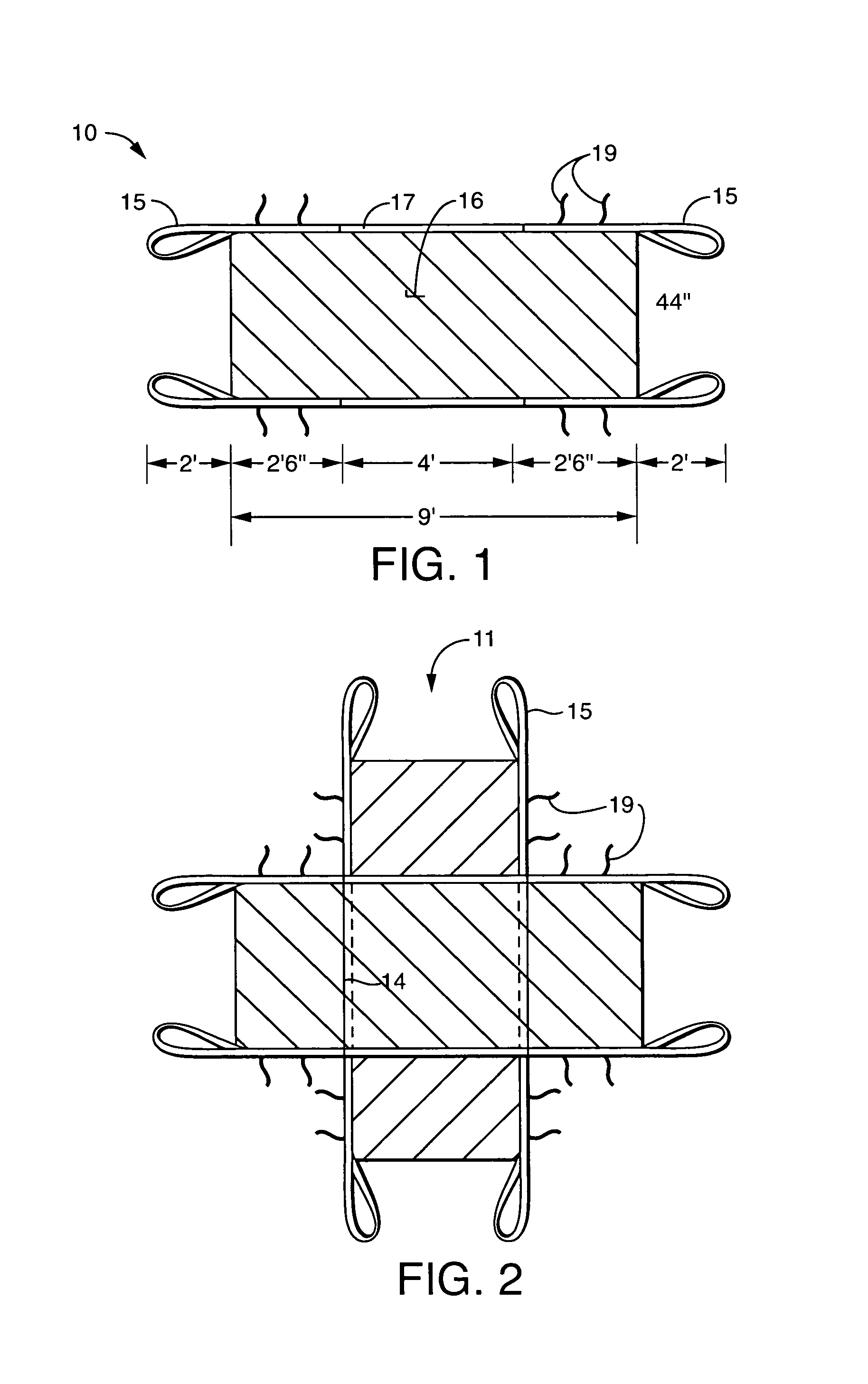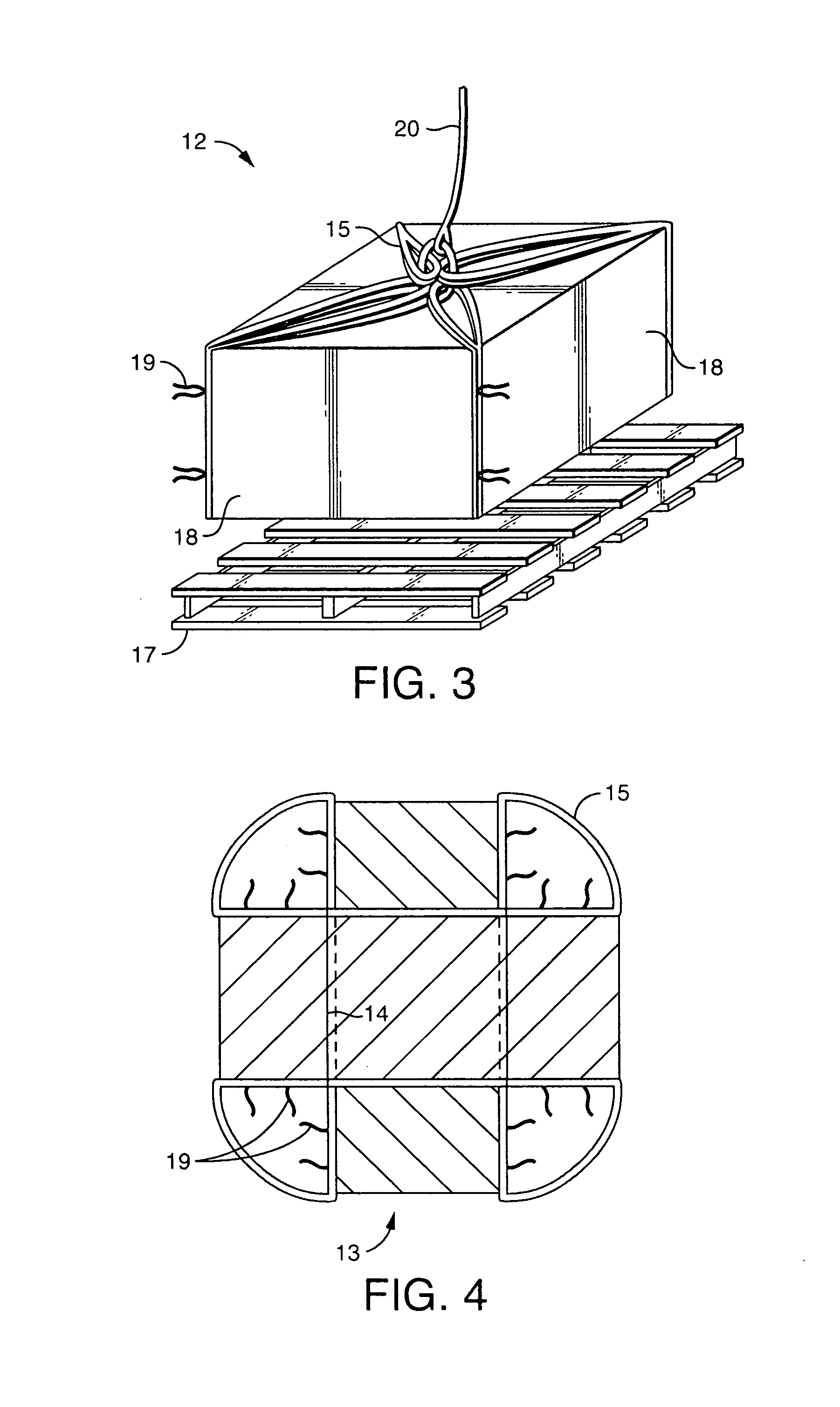[0005]The present invention addresses and overcomes problems encountered when using burlap bags in association with diving companies, contractors and pipeline operators located on land and in large bodies of water protect pipelines. The SlingBag invention is especially superior in cost savings, flexibility, durability, and safety in the work place.
[0006]The SlingBag invention is generally comprised of a flexible sling that is designed to hold some sort of weighted material, such as burlap bags filled with sand or sand / cement. Typically, the flexible sling has lifting loops incorporated into it, to facilitate movement and placement of the burlap bags in association with a crane, simplifying installation. Also, the flexible sling is typically comprised of a fibrous material that allows water to permeate the sling when the sling is immersed. The flexible sling is typically a four-sided bag that opens up into a flat T-shaped mat, since this shape is more useful in filling on top of a pallet with some sort of weighted material inside burlap bags and being used in a pipeline setting. The T-shaped mat is typically constructed by overlapping two rectangular mats of the same size in a perpendicular manner, to form a “T” or cross, and durably affixing these two rectangular mats into a single T-shaped mat. In this configuration, the center panel of the T-shaped mat (where the two rectangular mats cross and overlap) is designed to fit on a standard transport pallet. This is the section onto which burlaps will be loaded, as this will form the bottom of the SlingBag. The remaining portions of the T-shaped mat (i.e. the side flaps which do not overlap ) will be folded up to act as the sides of the SlingBag during deployment. In the preferred embodiment, each of these side flaps will have two lifting loops, such that the SlingBag would employ eight lifting loops. Alternatively, a single lifting loop strap could connect from the corner of one side flap to the corner of the nearest other side flap, such that the Sling Bag would only employ four lifting loops. Other shapes are feasible for the flexible mat, so long as they have portions on each side of a central panel which will overhang a standard pallet sufficiently to contain a load as a sling when folded up. The T-shape is preferred because it is simple to construct, provides good containment of fill material loaded within the SlingBag, and provides a double-thick bottom for the SlingBag for durability and strength when lifting heavy loads.
[0008]In preferred form, the flexible sling has flexibility and handling advantages, specifically allowing for convenient loading of the SlingBag (with burlap bags) onto standard wooden pallets for transport. By folding the SlingBag's four-sided flaps up, the burlaps are securely bundled within the SlingBag. This allows for the bundled burlaps to be efficiently unloaded, and also allows for a stacking arrangement of pallets. So, preferably, the SlingBag invention comprises (2) 44-inch wide×9 feet long ultra violet polypropylene fabric mats with two 24 inch lifting loops on each 9-foot end. The two 9 foot long fabric mats are arranged in a cross section and mated together, forming a T-shaped mat with eight lifting loops. The T-shaped mat, in turn, becomes a four-sided SlingBag when the side flaps are folded up and tied into place. Each side flap has two-¼ inch×10-inch long ties sewn to the webbing straps that are spaced 10 inches apart. During the filling operations (burlap bags with dry bulk sand or sand / cement) at the plant, the SlingBag is centered on top of a standard 40 inches×48 inches wooden pallet and the filled burlap bags are stacked on top. The SlingBag's four sides are raised and the ties on the side flaps are tied together in a knot. The eight lifting loops are tied at the top of the burlap bag pallet for lifting (by a crane) and setting onto the desired location. The SlingBag and burlap bags may also be water sealed on the outside with a layer of polyethylene offshore shrink-wrap. A forklift is all that is then required to load and unload the pallets. A total of 14 or 15 pallets can be trucked at one time. Pallets loaded using this invention can be stacked two pallets high to save valuable cargo space. The invention size when it is lifted by the lifting loops is 44 inches×44 inches×30 inches high and weighs approximately 3,360 lbs. The SlingBags are safer to handle and help the contractor save time.
[0009]These flexible SlingBags are specifically to be used as pre-installed lifting bags on burlap bag's pallets. This time saving process enables the burlap bags to be picked-up from the pallet and lowered to its job sight using a crane with a single point pick-up. With additional slings, more pallets can be pick-up at one time. A diver or remote operated vehicle (ROV) can release the burlap bags from the SlingBag once it is underwater. The wooden pallet never leaves its storage place on the offshore vessel. If necessary, the SlingBag can be left underwater. If the SlingBags are left in place underwater while fully loaded, this allows for easy and quick removal and replacement, as for maintenance of the pipeline. When the SlingBags with sand / cement burlap bags are placed on the location, and water sets in, the sand / cement in the burlaps will harden to concrete in approximately 4 hours or less. By hardening after it is set in place, the burlaps will conform completely to the pipeline or the covered area to be protected. By leaving the SlingBag in place, the burlap bags can easily be removed if access is needed at a later date. Neither the concrete in its solid form, nor the polypropylene fabric material is subject to degradation or deterioration, providing long-lasting protection. Also, because of its size, the fact that it molds to the area to be covered, and the presence of lifting loops, maintenance and repairs to pipelines are simplified, since it is easy to remove and then reposition the SlingBag properly.
[0010]It is an object of the SlingBag invention to secure pipelines in place on the floor of bodies of water. It is another object of this invention to protect pipelines from damage from impact by shielding the pipelines from direct contact with debris. It is still another object of this invention to protect the floor of bodies of water from erosion. It is yet another object of this invention to be convenient to transport and simple to install with a minimum of labor. It is yet another object of this invention to provide a safer procedure for lifting, lowering and releasing the burlaps on the ocean floor. It is yet another object of this invention to be flexible during installation, so that the SlingBag can precisely match the shape of the area it is covering, forming a secure fit. It is yet another object of this invention to be easily removable, so that the protective covering can be removed for maintenance and repair and then reinstalled. It is yet another object of this invention to be durable and long lasting, providing effective protection over an effective lifespan under the adverse conditions present in pipeline settings. These and other objects will be readily apparent to those skilled in the art field.
 Login to View More
Login to View More  Login to View More
Login to View More 


